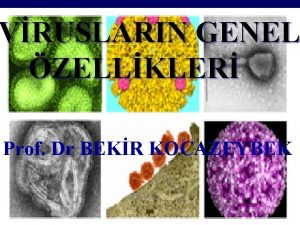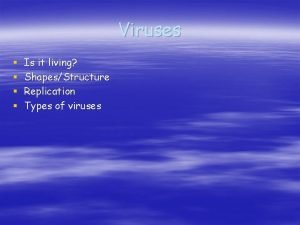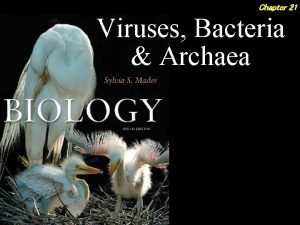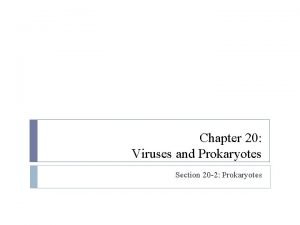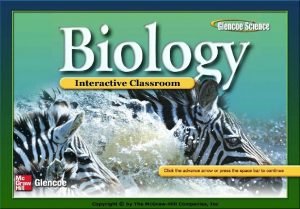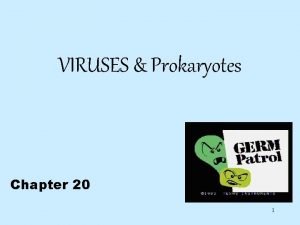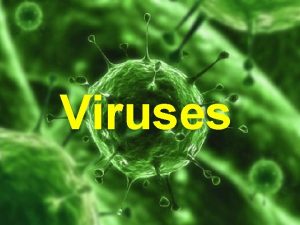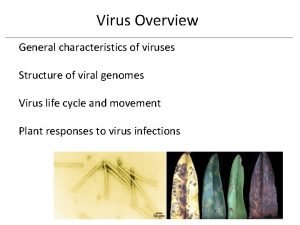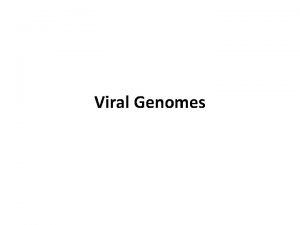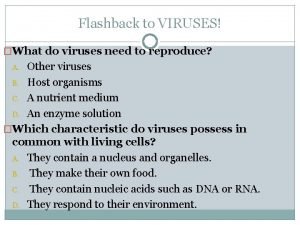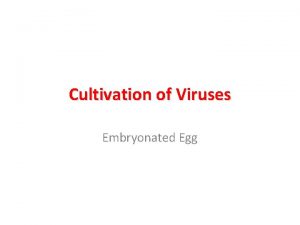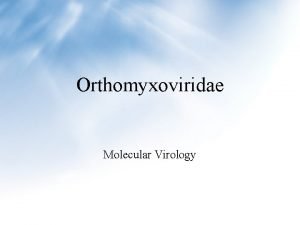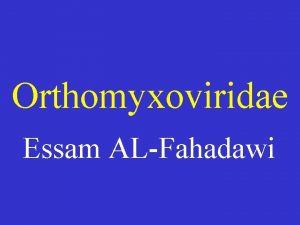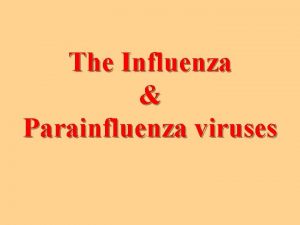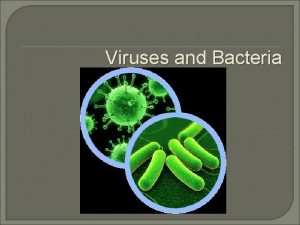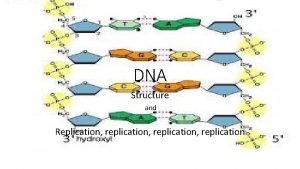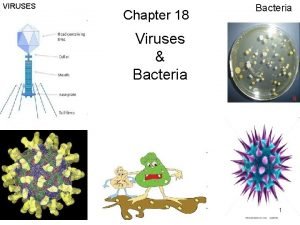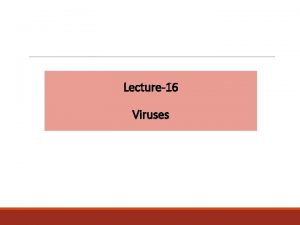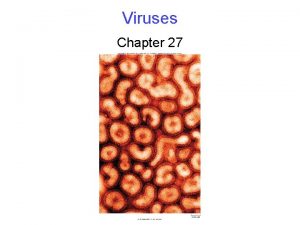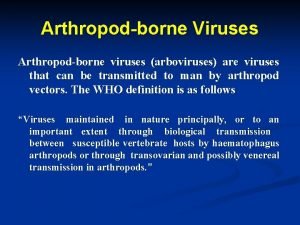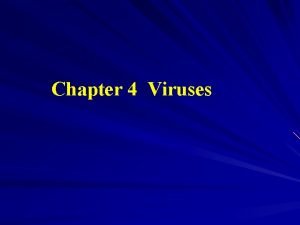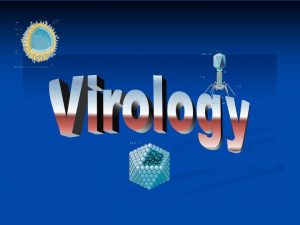Orthomyxoviridae The viruses and their replication stages of





















- Slides: 21

Orthomyxoviridae : The viruses and their replication -stages of viral replication

Influenza virus replication cycle 1. -Binding -Endocytosis -Fusion and uncoating -Releasing v. RNPs into cytoplasm 2. Import into the nucleus 3. RNA Replication 4. Translation 5. a transport back 5. b Secretion 6. Assembly 7. budding out

Influenza virus RNA synthesis NTR Poly adenylaion signal cap Fig. 47. 17 NTR : conserved non-coding region segment-specific nucleotide(NNN) UCGC- PB 2, PB 1, PA, UCGU- HA, NP, NA, NS, M c. RNA : exact positive-sense copy of v. RNA Poly(A) tail

Transcription and Replication Influenza virus m. RNA는 cellular RNA polymerase II activity에 의존하여 합성 Cap snatching : host pre-m. RNA transcript에서 5’capped primer를 훔쳐온 다. cap-binding function of PB 2 protein endonuclease function of PB 1 protein

Transcription and Replication transcription initiation, elongation, and polyadenylation of influenza virus m. RNA Corkscrew configuration Fig. 47. 20 A. 5’ v. RNA가 polymerase complex PB 1 subunit에 위치한다. 그러면 PB 2의 cap binding activity가 활성 된다. cellular pre-m. RNA 부착 B. 3’ v. RNA 가 PB 1에 붙어서 duplex가 된다. PB 1의 endonuclease activity에 의해 cap structure가 잘린다. 10~13 nt

Transcription and Replication transcription initiation, elongation, and polyadenylation of influenza virus m. RNA Fig. 47. 20 C. Capped primer의 3’end에 guanosine residue가 첨가된다. 그리고 v. RNA 3’end C와 base pair를 이룸 으로서 translation이 개시된다. PB 1의 polyerase function에 의해 chain elongation된다. D. elongation 과정 중 cap이 polymerase로부터 떨어진다. v. RNA의 5~7개 uridine 부분을 계속적으로 읽어서 poly(A)tail이 생긴다. 약 16 nt v. RNA polyuridine stretch 이후 부분은 steric hindrance에 의해 읽히지 못하고 translation 이 자동 종결된다.

splicing Virus splicing : cellular splicing machinery 이용 Steady-state level of spliced viral transcripts is only 10%. unspliced viral transcript Splicing is tightly regulated. negative feedback : NS 1 m. RNA export NS 1 protein 존재 할때 나머지는 NS 1(unspliced), and NEP/NS (spliced) transcript export 저해 inhibition NS 1의 cis-acting sequence : negatively regulate splicing M 1역시 이와 같은 방법으로 nuclear export 조절하고, 뿐만 아니라 viral polymerase와 cellular splicing factor에 의해서도 transcript slicing이 조절 된다.

The switch from m. RNA to c. RNA synthesis m. RNA는 cap과 poly(A) tail이 있어서 v. RNA와 모양이 조금 다르다. Primer –dependent mechanism c. RNA 는 v. RNA 를 주형으로 복제되어 더 한 것도 빠진 것도 없는 완벽하게 상보적 인 가닥이다. Primer-independent mechanism



Regulation of viral gene expression 단백질의 역할에 따라 gene expression 조절 NP : replication시 필요 NS : host immune response 에 저항 virus life cycle의 early stage 에 발현 M 1 : viral transcription 저해 virus life cycle의 later stage 에 발현 v. RNA promoter에 의해 gene expression 조절 4 UCGC- PB 2, PB 1, PA, UCGU- HA, NP, NA, NS, M C 4 -containing promoter 역할 : downregulation of transcription upregulation of replication

Nulear export of ribonucleproteins v. RNA+NP protein M 1이 관여 : 핵 내에서 RNP에 결합한다. M 1 -v. RNP complex NEP/NS 2 가 관여 : NEP/NS 2와 M 1의 상호작용 에 의해 RNP-M 1 -NEP/NS 2 complex가 형성된 다. 또 NEP/NS 2는 export receptor, Crm 1과도 상호 작용한다. RNP

Nuclear export of ribonucleproteins Fig. 47. 21 v. RNP의 핵 방출은 viral nuclear export protein(NEP/NS 2)에 의해 일어난다. NEP/NS 2는 M 1 protein을 통해서 cellular export factor, Crm 1, and v. RNP 와 상호작용 한다. Nuclear pore 통해 cytoplasm으로 수송이 일어난다.

Nuclear export of ribonucleproteins Fig. 47. 21 NEP/NS 2의 N-terminal 부분의 methionine/leucine – rich region이 nuclear export signal(NES)이다. 이 NES에 의해 방출된 단백질 수용체

Nuclear export of ribonucleproteins RNP export in influenza B and C virus 공통점 : NEP/NS 2 protein이 nuclear export activity지닌다. Crm 1과 상호 작용 한다. NES motif도 있다. 다른점 : B virus는 NEP/NS 2가 M 1의 상호 작용 없이 RNP와 M 1에 directly binding. C virus는 NES의 domain이 다르다.

Virus assembly and release the site of virus assembly and budding Viral pathogenesis 와 tissue tropism에 중요한 역할을 한다. 예) Marburg virus 같은 경우, internal cell surface에서 budding 되므로 systemic disease 유발. influenza virus 같은 경우 , external cell surface에서 budding 되므로 제한된 tissue tropism 을 나타냄. 사실상 HA 나 NA는 virus budding 에 필수적인 것은 아니다. HA-deficient virus, NA-deficient virus 모두 budding 가능. Virus assembly에 필수적인 것은 matrix protein이다. HA 와 NA의 sorting signal 이 transmembrane domain (TMD)에 존재.

Virus assembly and release M 1 protein : most abundant virion protein Lipid envelope 바로 밑에 존재. RNP와 glycoprotein의 cytoplasmic tail과 접촉한다. Viral component를 recruiting 한다. M 1 없이 budding 일어나지 않는다. (M 1주 도) Late(L) domain : viral budding의 late stage 에 필요한 host factor recruiting

Packaging of eight RNA segment 두 가지 모델 Random incorporation model Selective incorporation model Fig. 47. 23 Packaging signal : v. RNA 를 virion으로 incorporation

Release Virus는 sialic acid-containing receptor와 binding 되어 있기 때문에 sialic acid를 carbohydrate로부터 떼어 줘 야 한다. HA Receptor binding activity VS NA Receptor destroying activity

Release-nuraminidase Second major glycoprotein 9 subtype of A virus (N 1, N 4, N 5, N 8/N 2, N 3, N 6, N 7, N 9) Highly conserved short cytoplasmic tail Hydrophobic transmembrane region anchor 역할 : Releasing the virus Cleansing the environment of sialic acid receptor Facilitating entry of the virus Enhancing late endosome/lysosome trafficking

 Https://m..com/watch?v=nqecciuc7jy
Https://m..com/watch?v=nqecciuc7jy Watch?v=dhlvcdeg0yg
Watch?v=dhlvcdeg0yg Orthomyxoviridae
Orthomyxoviridae Familia orthomyxoviridae
Familia orthomyxoviridae Replication of viruses
Replication of viruses Bioflix activity dna replication lagging strand synthesis
Bioflix activity dna replication lagging strand synthesis Section 19-3 diseases caused by bacteria and viruses
Section 19-3 diseases caused by bacteria and viruses Egrette chapter 21
Egrette chapter 21 Chapter 20 viruses and prokaryotes
Chapter 20 viruses and prokaryotes What are viruses lesson 3
What are viruses lesson 3 Chapter 20 viruses and prokaryotes
Chapter 20 viruses and prokaryotes Chapter 18 section 2 viruses and prions
Chapter 18 section 2 viruses and prions Section 1 studying viruses and prokaryotes
Section 1 studying viruses and prokaryotes Why are viruses considered nonliving?
Why are viruses considered nonliving? General characteristics of viruses
General characteristics of viruses General characteristics of viruses
General characteristics of viruses Viruses
Viruses Lysogenic viruses do not
Lysogenic viruses do not Cultivation of viruses
Cultivation of viruses Viral inoculation in embryonated egg
Viral inoculation in embryonated egg Blood borne viruses
Blood borne viruses Are viruses alive yes or no
Are viruses alive yes or no


